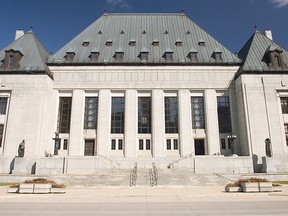World
Supreme Court Strikes Down Mandatory Minimum Sentences for Child Pornography

A recent ruling by the Supreme Court of Canada has generated significant controversy by declaring a one-year mandatory minimum sentence for child pornography as cruel and unusual punishment. The decision, supported by a majority of five judges, has drawn sharp criticism for its implications on the judicial system’s approach to child sexual exploitation.
In a judgment authored by Justice Mary Moreau, the court asserted that the mandatory minimum sentence was unconstitutional. Critics argue that this decision undermines the severity of crimes involving child pornography. Specifically, the ruling emphasized a so-called “reasonable hypothetical,” which many believe lacks grounding in the actual cases presented before the court.
Concerns Over Judicial Reasoning
The cases involved two individuals, Louis‐Pier Senneville and Mathieu Naud, both of whom admitted to possessing hundreds of explicit images of children. Senneville was found with 475 files, including 317 images of children, with the majority being girls aged between 3 to 6 years. Naud’s collection was similarly alarming, comprising 531 images and 274 videos of minors aged 5 to 10 years being sexually abused.
Despite the severity of these cases, Justice Moreau’s ruling referenced a hypothetical scenario involving an 18-year-old receiving a “sext” from a friend, suggesting that such a situation could equate to child pornography. Critics argue that this comparison trivializes the actual crimes involved, as it distracts from the grave realities faced by victims of child exploitation.
Chief Justice Richard Wagner, along with Justices Suzanne Cote, Malcolm Rowe, and Michelle O’Bonsawin, dissented, emphasizing that the objectives of denunciation and deterrence are paramount in cases of child pornography. Wagner stated that the court must recognize the seriousness of these offenses to adequately protect society and deter future crimes.
Implications for Future Legislation
The ruling has raised questions about the role of the judiciary in interpreting laws regarding child sexual offenses. Several legal experts suggest that Parliament may need to intervene to clarify the limits of judicial discretion in applying hypothetical scenarios in their decisions.
The dissenting opinion highlighted the need for lower courts to adopt a more stringent approach toward sentences for child sexual offenses, urging a reassessment of how such cases are handled in the judicial system. The majority’s decision has sparked a debate on the balance between judicial interpretation and the responsibility to protect vulnerable populations.
The Supreme Court’s ruling has not only impacted the legal landscape but has also prompted public outcry regarding the potential for leniency in sentencing for heinous crimes. As discussions continue, advocates for child protection are calling for reforms that prioritize the safety and well-being of children over theoretical judicial interpretations.
This decision marks a pivotal moment in the ongoing dialogue surrounding child protection laws in Canada, reflecting broader societal challenges in addressing the complexities of child sexual exploitation. The attention now turns to lawmakers and legal authorities to ensure that justice for victims remains a priority in the face of evolving judicial interpretations.
-

 Science3 months ago
Science3 months agoToyoake City Proposes Daily Two-Hour Smartphone Use Limit
-

 Top Stories3 months ago
Top Stories3 months agoPedestrian Fatally Injured in Esquimalt Collision on August 14
-

 Health3 months ago
Health3 months agoB.C. Review Reveals Urgent Need for Rare-Disease Drug Reforms
-

 Technology3 months ago
Technology3 months agoDark Adventure Game “Bye Sweet Carole” Set for October Release
-

 World3 months ago
World3 months agoJimmy Lai’s Defense Challenges Charges Under National Security Law
-

 Lifestyle3 months ago
Lifestyle3 months agoVictoria’s Pop-Up Shop Shines Light on B.C.’s Wolf Cull
-

 Technology3 months ago
Technology3 months agoKonami Revives Iconic Metal Gear Solid Delta Ahead of Release
-

 Technology3 months ago
Technology3 months agoApple Expands Self-Service Repair Program to Canada
-

 Technology3 months ago
Technology3 months agoSnapmaker U1 Color 3D Printer Redefines Speed and Sustainability
-

 Technology3 months ago
Technology3 months agoAION Folding Knife: Redefining EDC Design with Premium Materials
-

 Business3 months ago
Business3 months agoGordon Murray Automotive Unveils S1 LM and Le Mans GTR at Monterey
-

 Technology3 months ago
Technology3 months agoSolve Today’s Wordle Challenge: Hints and Answer for August 19









